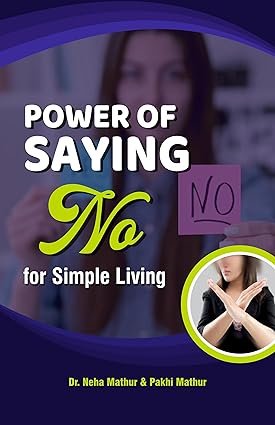1. Introduction

The book Saying No: A Path to Mental Health and Self-Care, published by Shine Book Publishing, highlights the importance of learning to say ‘no’. It offers a concise yet impactful guide on how this simple word can improve mental health. The book also discusses how saying ‘no’ can build self-esteem and help individuals prioritize their well-being. The author, whose background remains mostly anonymous, brings a relatable voice to the subject. The author focuses on practical advice for those who struggle with setting boundaries. Consequently, the book provides valuable insights for anyone looking to protect their mental health in today’s fast-paced world.
Have you ever felt guilty or anxious about declining requests or invitations? Share your thoughts in the comments below—let’s start a conversation about the importance of saying ‘no’!
2. Why Should You Read This?
In an age where constant connectivity and societal pressure make it harder to say no, this book offers a much-needed perspective. The relevance of learning how to set boundaries has never been higher, especially with stress levels at an all-time high. Mental health concerns are also taking the spotlight globally. Unlike many self-help books that focus solely on productivity, Saying No emphasizes the importance of self-care and emotional well-being. It helps readers understand that their time and energy are finite resources. As a result, the book encourages a healthier approach to balancing commitments and personal well-being.
The book taps into an emerging social awareness that saying ‘no’ is not a weakness but a strength, making it a must-read for those looking to maintain a healthier mental and emotional balance in their lives.
3. Key Teachings and Themes
The central theme of Saying No is the importance of setting personal boundaries without feeling guilt or obligation. The author focuses on how mastering the art of refusal can lead to significant improvements in both mental and physical health. Key lessons include:
– The Empowerment of Saying No: Learning that saying no is not selfish but essential for self-preservation.
– Boundary Setting: Strategies to set clear boundaries in personal and professional relationships.
– Stress Reduction: How saying no can decrease stress and increase overall happiness.
– Politeness without Obligation: Techniques to decline invitations or demands politely yet firmly.
One memorable quote from the book is, “Saying ‘no’ to others is saying ‘yes’ to yourself.” It encapsulates the essence of the book’s message, encouraging readers to reclaim their time and mental energy.
4. How This Book Can Help You
Reading Saying No offers several practical and intellectual benefits:
– Mental Health Improvement: The book provides actionable advice on how to reduce stress and anxiety by learning to say no without guilt.
– Enhanced Self-Esteem: It teaches readers how to feel confident about their boundaries, which can help boost self-esteem and personal happiness.
– Work-Life Balance: For those struggling with overcommitment, the book shows how saying no can help achieve a better work-life balance.
By incorporating the lessons from this book into your daily life, you can gain more control over your time, improve your mental health, and build stronger, healthier relationships.
5. Writing Style and Structure
The author’s writing style is simple yet engaging, making the book accessible to a wide audience. With only 124 pages, it’s a quick read, but its compact size doesn’t detract from the depth of its message. The chapters are well-structured, with each focusing on a different aspect of saying no—be it in personal relationships, work environments, or social settings. The clarity of the writing helps readers easily grasp complex emotions surrounding the act of refusal.
6. Criticism of the Book
While the book offers valuable insights, it is not without its shortcomings. At just 124 pages, some readers might find it lacking in depth. For those already familiar with the topic of boundary setting, the content may feel somewhat basic, and the advice can sometimes seem repetitive. Additionally, the author’s anonymity makes it difficult to assess their expertise fully, which could affect credibility for some readers.
However, for those new to the concept of saying no, these limitations do not detract from the book’s practical usefulness.
7. Why Summary Is Not Enough
A summary might give you an idea of the book’s core messages, but it cannot replace the full experience. The power of Saying No lies in its relatable examples, step-by-step techniques, and thought-provoking exercises that guide readers through the often uncomfortable process of declining requests. Experiencing the book firsthand allows readers to internalize its teachings and apply them to their lives more effectively.
8. Thought-Provoking Debates
The subject of saying no can lead to rich discussions, especially in a culture where people are often expected to be endlessly accommodating. One potential debate is whether saying no too often might isolate individuals socially or hinder professional opportunities. Readers are invited to reflect on how to balance self-care with the need for connection and growth, both personally and professionally.
9. Who Should Buy or Read This?
This book is ideal for anyone who struggles with overcommitment or feels overwhelmed by life’s constant demands. It’s particularly useful for:
– Young professionals trying to balance their careers and personal lives.
– People-pleasers who find it hard to set boundaries.
– Individuals seeking stress relief through better time and energy management.
It also makes for a thoughtful gift for friends or family members who need a gentle nudge towards self-care.
10. Reasons Not to Buy/Read
Despite its merits, Saying No may not be the right fit for everyone. Here are a few reasons someone might choose not to read it:
– Already Familiar with the Topic: If you’ve already read extensively on boundary-setting or self-care, this book might not offer enough new insights.
– Not a Priority: If learning to say no is not currently a priority, this book may not resonate or feel relevant to your current life situation.
11. Conclusion

Saying No: A Path to Mental Health and Self-Care is a timely and relevant book that highlights the importance of personal boundaries. Its focus on mental health, self-esteem, and stress reduction makes it a valuable resource for anyone looking to take control of their life by learning when and how to say no. Though brief, the book provides practical advice in an accessible format that will resonate with readers at all stages of life.
12. Final Recommendation
Overall, Saying No is a highly recommended read for those who struggle with overcommitting or feel pressured to constantly say yes. The book’s practical approach to boundary setting is particularly beneficial for young professionals, individuals dealing with stress, and people-pleasers. While it may not be groundbreaking for those already well-versed in the topic, it offers an easy-to-follow guide for beginners.
Final Rating: 4 out of 5 stars. If you’re looking to reclaim your time and mental health, this book is a great place to start.
Insights from Trapbreaker.com
For those of you who’ve arrived here through our partner site trapbreaker.com, we appreciate your interest in learning more about this book. On trapbreaker.com, our team focuses on helping readers recognize and sidestep common life traps. This book, The Power of Saying No, was recommended for its practical advice on setting boundaries and avoiding manipulation.
Here on awareandbeware.com, we dive deeper into its strengths and limitations to help you decide if it aligns with your goals. If you haven’t checked out the blog – Shocking Habits Harming Your Mind: Find Out Now! (Part 2/4) on our partner site trapbreaker.com, we encourage you to do so. It explores how this book fits into a strategy for smarter, more self-aware decision-making.

